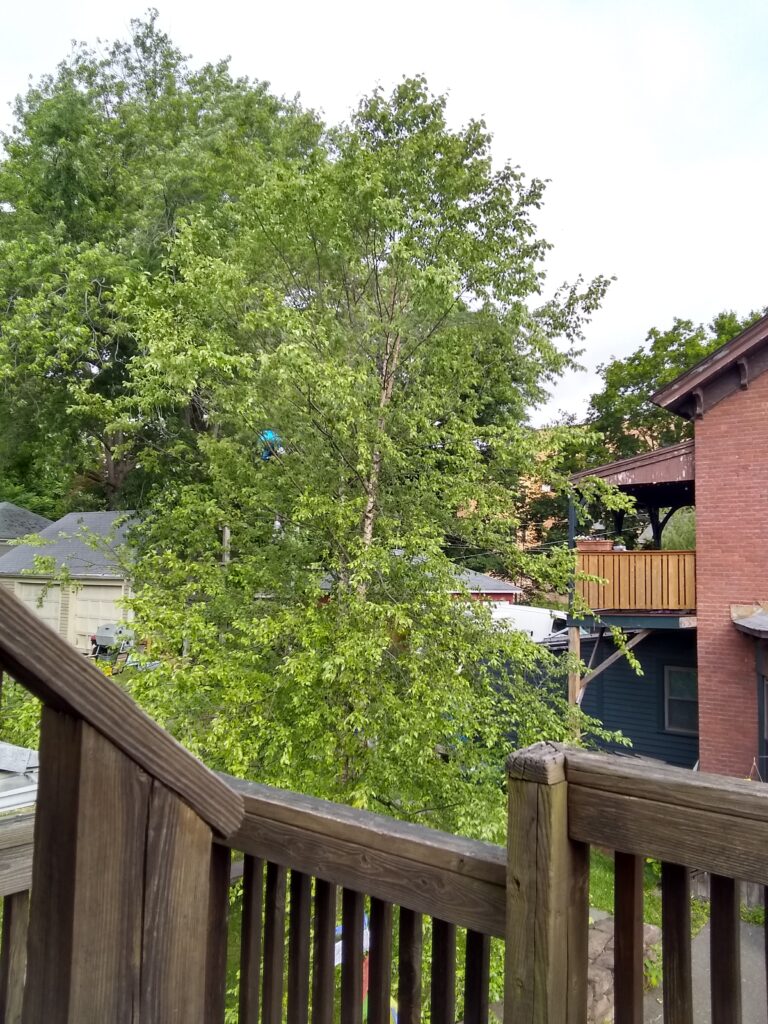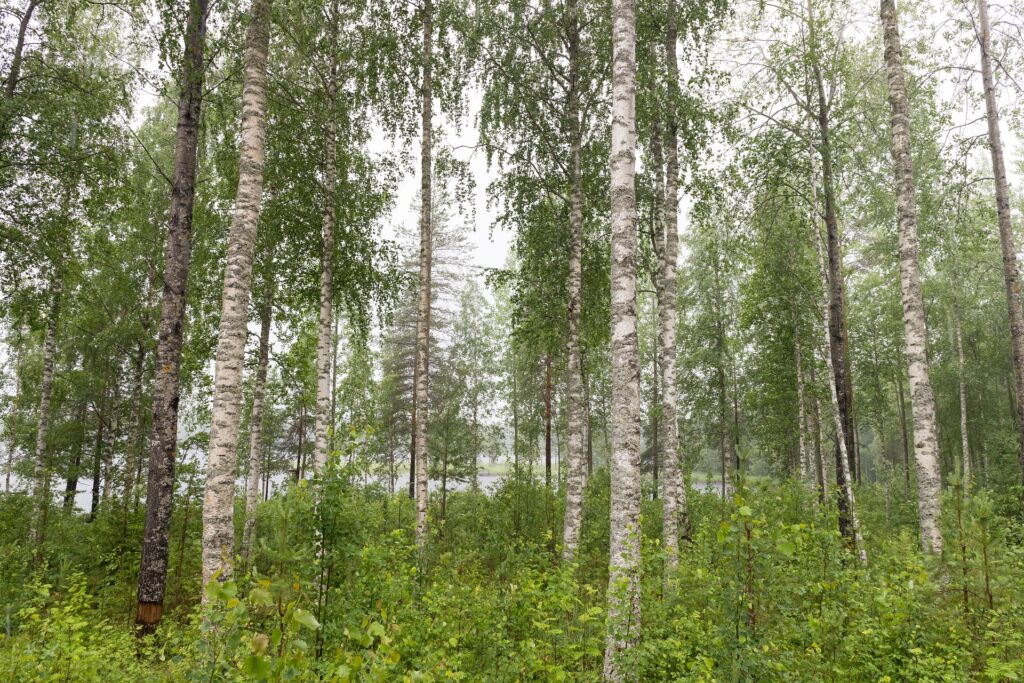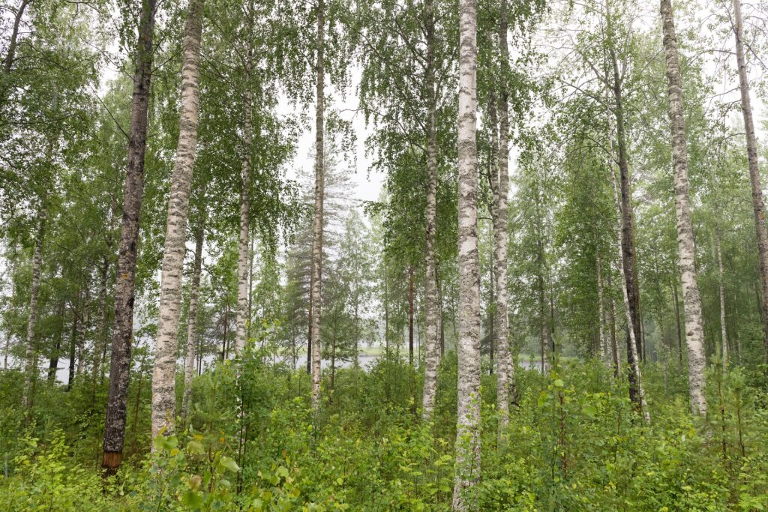These past months I have found myself in communion with a lone river birch outside my 3 foot by 2 foot back deck (ok, stairway). I meditate there each morning and gaze at this tree (as opposed to a neighboring house, the street, my doorway, or into another neighbor’s kitchen).
 As I wrote this essay over the course of a few days, some half mangled graduation balloons settled in River Birch’s branches. Just coincidence or symbolic timing to reinforce the themes of this reflection? (Photo by author)
As I wrote this essay over the course of a few days, some half mangled graduation balloons settled in River Birch’s branches. Just coincidence or symbolic timing to reinforce the themes of this reflection? (Photo by author)
It (or more correctly Ki) is good company—sparrows, starlings, blue jays, and beautiful yellow birds I don’t know the name of regularly land in the birch’s branches and look at me, sometimes even sing to me. Squirrels scurry up and across its limbs, and the seasons reveal themselves with the subtle arrival, dance, and departure of its many dainty leaves.
But this little tree also brings me a bit of sorrow. It will never live out its full “tree nature.” Its roots are limited by stone and asphalt in three directions. It is alone in the yard, perhaps intertwined and communicating with the large silver maple in the next yard over, perhaps with the young red oak in the front yard, but then again, perhaps not. The distance is not insubstantial; the soil is clay, and compacted over the years of this yard being a sprawling parking lot covered in asphalt. It may be alone.
These interactions remind me that living as we do stunts the true nature of many species—whether the trees, the birds who, like feral pets, eat from the surrounding backyard bird feeders, or, and especially, us. Living inside a house, as detached from nature as I am, I am no longer aware of natural cycles, unable to hunt or provision food from my environment,* or, or, even know what I don’t know (to get a bit Rumsfeldian). There’s so much knowledge and wisdom lost that it’s not even a memory anymore. Like this solitary tree that even if it connected with other trees may no longer have the ability to process or understand other trees’ signals—like humans struggling to learn languages after the early period of brain plasticity ends.
And while I’m trying to live differently, at best that means taking my pot outside to get some sun and wind and maybe a bit of rain for some minutes each day, which obviously is not enough. My roots are still locked in their shallow tray and my understanding of Gaia is stunted like a bonsai.
Even my son, who I am very proud to bring to forest school every week (and who blew me away this week asking me: if you could have one skill better than anyone in the world what would it be? I couldn’t answer but he answered for himself, “primitive skills.”),** even he is at best a backyard tree. A few of his roots may be touching other trees, but the majority are bumping against the surrounding parking lots and foundations.
I’m not beating myself up about this, just recognizing the reality of it. Perhaps during this transition between our current consumer and the post-consumer reality that is coming whether we want it or not, the best we can do is plant more backyard trees with the hope that they seed forests in the ruins of suburbia (literally but more so figuratively). But I think perhaps there is more we can do. As I mentioned this yard was once a giant parking lot. It is now filled with garden beds and grass.*** And this lovely tree. Rewilding or even de-asphalting is an essential step for both our physical—and mental—landscapes. That takes time, and work, commitment, and maybe even a bit of (metaphorical) heavy machinery. Making time for truly being in nature, and finding mentors to help regain some of the lost understanding (especially for your children or grandchildren who may be able to understand and internalize it better) may be two of the essential steps in this process.
Every tree matters—even stunted ones living out just a shadow of their tree nature—so get your shallow tray out of the house when you can, or, if possible, find ways to plant your roots in the ground outside.

Birch trees living out their full birch nature. (Image by zanna-76 from Pixabay)
Endnotes
*If the landscape even could provision me at this point. Another time this week as I walked home past a beautiful plum tree in a local park—one I have gratefully taken plums from for years but one that seemed to get so much attention last summer that there are now signs asking people to let it be—I once again realized that when the grain stops flowing, people will have very little understanding or ability on how to find food. With our sheer numbers, I worry how we’ll cope with that. It’s an important reminder to build both your own reserve (justly and respectfully) and especially build your local community and guild resilience.
**His words. There is awkwardness in the language around nature skills currently and go by many different descriptors: Indigenous skills, primitive skills, ancestral skills. Primitive has a negative connotation to some, which is not implied here, but we frequently went to the Mid-Atlantic Primitive Skills meet so I think primitive has stuck. Perhaps primeval is a better word? Symbiote skills? This certainly gets to the heart of it. Though Ancestral feels the most right to me as it helps re-tie us to the great cycle of life and wisdom of our forebears.
***Thanks to the great work of my neighbor.





